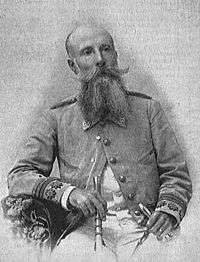Joaquín Vara del Rey y Rubio
| Joaquín Vara de Rey y Rubio | |
|---|---|
 | |
| Born |
1840 Ibiza, Spain |
| Died |
July 1, 1898 (aged 57–58) El Caney, Cuba |
| Allegiance |
|
| Service/branch | Spanish Army |
| Years of service | 1862–1898 |
| Rank | Brigadier General |
| Battles/wars |
|
| Awards | Laureate Cross of Saint Ferdinand |
Joaquín Vara de Rey y Rubio (1840 – July 1, 1898) was a career Spanish officer. He is best known for leading the stubborn defence of El Caney against a massively superior American army during the Spanish–American War.
Military career
Vara de Rey was born in Ibiza in 1840. He graduated as a second lieutenant from the Colegio General, rising to the rank of first lieutenant in 1862. He fought against uprisings in Cartagena and Valencia and against the Carlists in the Carlist Wars. He requested a transfer to the Philippines in 1884 and remained there until 1890, serving as Captain General of the Philippines and governor of the Mariana Islands.
In 1895, Vara de Rey volunteered for service in Cuba. He commanded the Spanish forces at Bayamo and led his regiment to victory at the Battle of Loma de Gato in which the Spaniards killed revolutionary leader José Maceo, brother of Antonio Maceo Grajales.
On July 1, 1898, Brigadier General Joaquín Vara de Rey, with only 550 men and no artillery, heroically defended El Caney for ten hours against a U.S. army 12,000 strong and better armed. Vara de Rey lost two sons in the battle and was himself mortally wounded in the fighting; only 84 Spanish soldiers survived unscathed.
Impressed by his generalship, U.S. troops buried Vara de Rey with full military honours. American accounts of the campaign praised the "magnificent courage" of Vara de Rey's soldiers and described the man as "an incomparable leader; a heroic soul."[1] Vara de Rey's remains were repatriated to Spain in November 1898 with American cooperation. He was posthumously awarded the Laureate Cross of Saint Ferdinand, Spain's highest military decoration.
Notes
- ↑ Albert A. Nofi. From 'Dagoes' to 'Nervy Spaniards' American Soldiers' Views of their Opponents, 1898 On War and Warfare.
References
- Albert A. Nofi (1997). The Spanish-American War, 1898. Combined Books. ISBN 0-938289-57-8.
